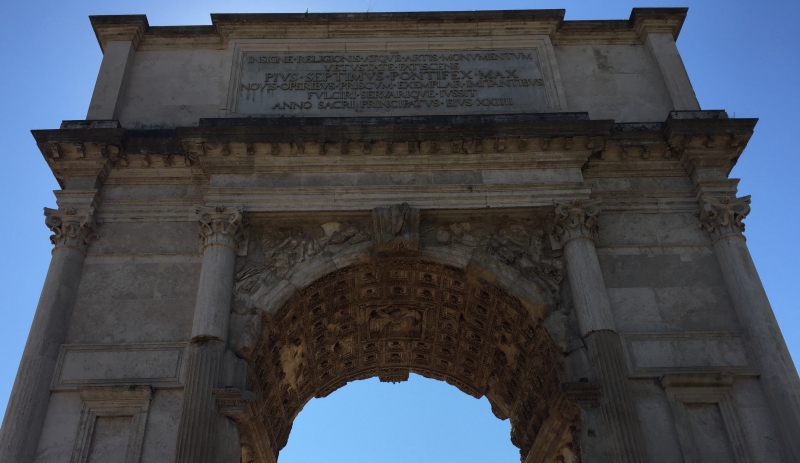
Arch of Titus, Forum Romanum (4/7/2017)
Liberal Arts and Natural Sciences Rome study tour: 3rd-8th July 2017
One of the pleasures of being Dean is that I have twice had the opportunity to spend a summer week learning with and from a cross-section of our LANS students, while also talking to them about my own area of research expertise, the turbulent years of the late Roman Republic (the first century BCE) and the impact of that revolutionary era on how modern citizenship continues to be defined and contextualised. I blogged that first trip, and will try not to replicate too much of what I recounted there, here 🙂
With University of Birmingham doctoral candidate Miriam Bay, and guided by the wonderful Agnes Crawford, we worked our way through Rome and its environs with thirteen LANS students, moving from radical urbanism in classical antiquity to the modern city’s shifting acknowledgement of the importance and perils of embracing change.
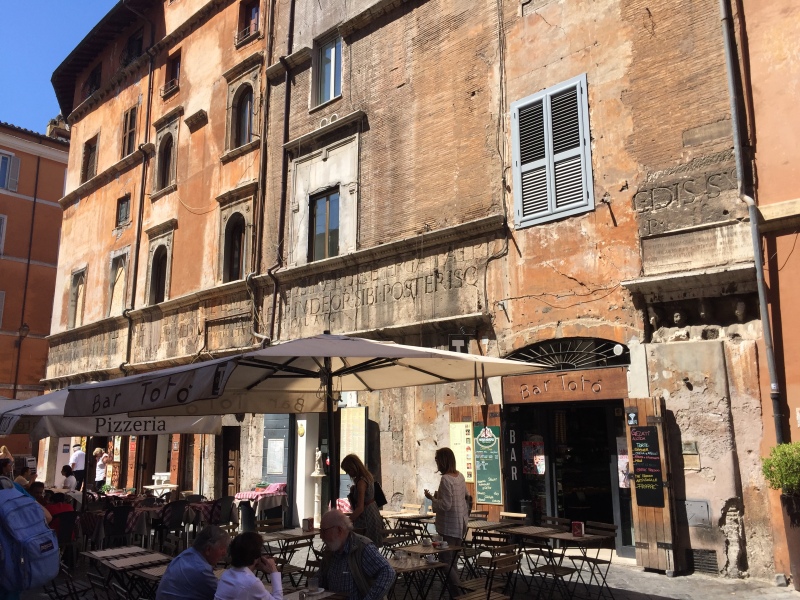
Streets in Rome’s Ghetto amply evidence the ‘layered’ quality of the cityscape (4/7/2017)
Rome, for me, is the ultimate laboratory city. Perhaps it’s my research focus talking, but in articulating my vision of what the tour would deliver (when describing it, back in January, to an interested but uncertain group of potential student travellers) I saw the sparks of questions, challenges, ideas, and responses flicker across their faces; to reappear over the ‘welcome’ dinner we hosted (at L’Isola della Pizza) for the whole group on 3rd July 2017, and as we made our first foray into the Forum Romanum early morning on 4th July.
Day 2 (4 July 2017)
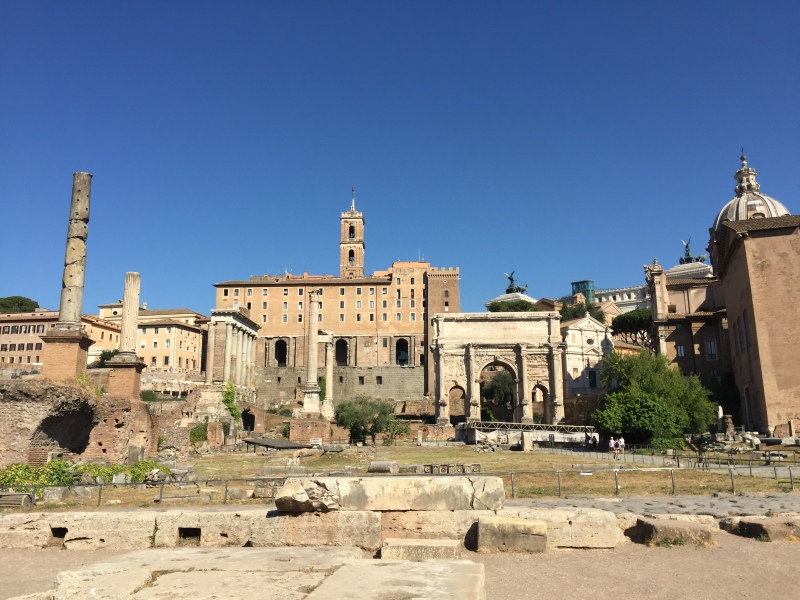
Spoliation, repurposing, but also the lure of genius loci are all on display for scrutiny (4/7/2017)
As Agnes emphasised, that calendar serendipity gave bite to our consideration of the complex forces that cause a people to turn upon themselves in civil war and in the process, to scrutinise and find wanting a myriad previously unquestioned myths of self-determination. These were the years when autochthony and (in a phrase Agnes used as a motif for the week’s study) genius loci (spirit of place) crystallised within Roman identify-formation. By the second century BCE Rome controlled a growing Mediterranean empire; no longer a city-state confined by peninsular Italy, yet still uneasily related to the peoples and cultures of its nearest neighbours.
This was an era when land use and land rights, not to mention rural to urban migration, linguistic change, and a reverse cultural imperialism (speaking to and striking back at Rome) from the literate Hellenic kingdoms that had previously dominated the western world, were all troubling the growing and increasingly urban political elites. It was also an era in which centuries of oligarchic politics (res publica or ‘public affairs’) were foundering as charismatic individuals (reformers, agitators, cynics, soldiers, demagogues…) began to see ways to game the system and wrest control from the few — by promising to transfer it to the many.

The Temple of the Dioscuri — where we thought about how/why new gods get assimilated (4/7/2017)
Strolling through the Forum we considered how that genius loci paradoxically became a force for political and religious conservatism (‘we have always done x in y manner in z place, we always will; it’s who we are’) and also radical revisionism (‘by doing x in y place we validate transforming how, why, when, by whom it is done in z manner’). Thus, the Curia (a chamber used for meetings of the Senate, traditionally Rome’s conciliar body) which occupies a site by the Arch of Septimius Severus both is and is not the Curia constructed over two millennia before, by the Dictator (at that time still a regular office within consensus politics) ‘Lucky’ Sulla. And it also does and does not recall Mussolini’s early twentieth-century programme of laying bare, often with brutality to the urban fabric of the intervening centuries, what might be recalled to life as ancient proof of Rome’s destined imperial greatness.
As we discussed how the forces of history act not only on the fabric but also the context of how buildings function, we stopped at two evocative death zones. The mysterious Lapis Niger or ‘Black Stone’ (in one legend, the site of the burial of Rome’s founding father Romulus back in the eighth century BCE) is a waymarker for two other key funereal moments in the Forum: the riots, fires, and destruction that followed the deaths of Publius Clodius Pulcher (arch-nemesis of the orator and statesman Cicero) and, not long after, of Julius Caesar.

The Deified Julius’ temple abuts the former home of the Pontifex Maximus and the commercial and civic centre known as the Basilica Aemilia-Paulli which went through significant changes in form and use (4/7/2017).
The temple to the God Caesar, dedicated shortly after his assassination in March 44 BCE, brings that strand in urban morphology full-circle. Like charismatic leader Romulus (in one version of the legend), Caesar was killed by his colleagues — a rebel conservative group within the political elite. Also like Romulus, he gained permanence within the built environment of the Forum. As Agnes reminded us, the extraordinary thing for contemporary Romans to get their heads around must have been that while humans in myth did indeed cross over into divinity, this was the first time a man with whom one might have had lunch made such a transformation.
The Forum was the heart of the Republican-era city, and while it had few permanent inhabitants (exceptions: the Pontifex Maximus, or Chief Priest, plus the college of female priests called the Vestal Virgins, a powerful cadre of professionally unmarried women) it was the hub for the courts and legal activity, for religious practice, political deliberation, for marking the triumphant return of successful military commanders. It had shops, monuments, arcades within which to stroll, and before the construction of permanent theatres or amphitheatres, it was a space for staging public entertainments. Setting the new God Caesar in this context, in a brand new marble temple, sent a powerful political and cultural message to upholders of the previous status quo.
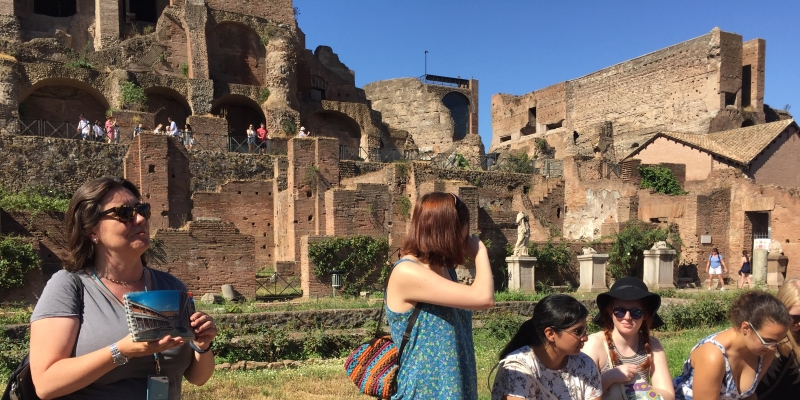
Pausing in the portico garden of the House of the Vestals gave us a chance to gaze up towards the Palatine Hill, and think about why statues are most vulnerable at their necks… (4/7/2017)
We spent the rest of the morning exploring the Palatine Hill, the zone towards which power began to shift under the next phase in Rome’s political development: the era of the Principate, ushered in by Caesar’s heir who took the honorific name Augustus.
Rome’s Seven Hills are famous (even if no-one in antiquity exactly agreed which of the many more than seven were the Seven), and the Palatine gave us the chance to talk through the rapidity with which political power shifts can become inscribed on physical topography, and in turn shift cultural expectations. Elevated on a hill, Augustus’ (relatively) modest house was gradually added to, first by him (the construction of a temple complex to the god who helped him come to power, Apollo) then by subsequent ‘emperors’ (a term which in antiquity meant someone with officially sanctioned power, but without the autocratic connotations we now attach to it).

Agnes talked students through the scale (size, wealth, grandeur) in advance to give context to the ruins/lost structures (4/7/2017)

Tantalising fragments of opus sectile hint at the opulence of spaces which moved guests between light/dark, quiet/loud, watery/dry (4/7/2017)

We left the Palatine after taking a stance on the Circus Maximus, and considering its significance for how/why the site of Rome was ideologically important (4/7/2017)
The vestigial remains of one part of that eventually imperial residential complex developed by the emperor Domitian (51-96 CE) showcased the superfluity and conspicuous consumption that characterised the powerful architectural and visual rhetoric of Roman ‘palace’ complexes (‘palace’ from…Palatine!). We would see aspects of this visual rhetoric (opus sectile, scale, complex geometric built form, rich materials) in the static experience and staged movement through space at the Pantheon (that afternoon), St. Peter’s and EUR (6 July), and Hadrian’s Villa (7 July).
After lunch we worked our way through the city zone that was in antiquity the Campus Martius (Field of Mars). Once outside the city limits, it was incorporated, shifting during the late Republic from a green-belt military exercise ground to an entertainment zone hosting the city’s first stone theatres, an amphitheatre, a grand public baths and gymnasium, gardens, galleries, and places of religious worship (including temples of some of the new gods Rome was so good at assimilating, for instance Egyptian Isis; but also giving us a chance to discuss a characteristically Egyptian power-icon, the obelisk, imported into Rome’s urban visual vocabulary).

Perhaps the remains of Egyptian Isis’ statue? (4/7/2017)

The Pantheon embodies the power of monumental inscriptions to conceal/reveal (4/7/2017)

S. Maria in Trastevere (4/7/2017)
We though about urban segregation: by ethnicity/religion (within the confines of the Jewish Ghetto), by risk (on Tiber Island, a place of isolation and healing of the sick since classical antiquity), and by choice (the changed urban dynamic reflected in Papal realignment of power at Rome centred on the north-west bank of the river, some distance from the historic centre).
At Santa Maria in Trastevere we concluded the day, thinking about ‘left bank’ politics, spoliation and continuity with classical antiquity, and how radical was the iconographic shift from medieval to renaissance rhetorics of power.
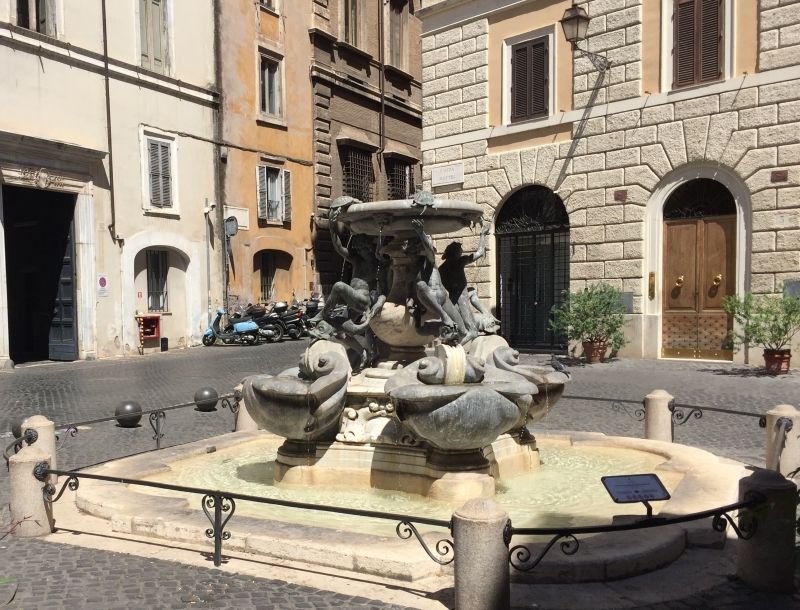
This charming fountain just outside the Ghetto belies the troubled history of Rome’s relationship with its Jewish population, and the wider challenges of how urban morphology aids/hinders integration (4/7/2017)
All these changes had deeply personal effects on individual lives, but also created seismic shifts in the economic, infrastructural, and political life of the city and its topography.
Day 3 (5 July 2017)
LANS students impressed us all with their ability to get up early and be on time for morning meet ups that were typically 0730! Students were staying in apartments on either side of the Tiber, and had to make their way independently every morning to the designated site — what stars they all were! Wednesday we were on a train to Ostia Antica by 0800 (some of us had postponed breakfast till the caffe at Porta San Paolo station…).

Getting our bearings on the Via Ostiense, 5/7/2017

Ostia’s elite town-houses helped to bring human scale to the ‘palatial’ ruins of Day 1 (5/7/2017)

Ostia, street scene (5/7/2017)

Ostia – making a theatrical pause (5/7/2017)

At the baths… (Ostia, 5/7/2017)

Learning to love (and learn from) brickwork (Ostia, 5/7/2017)
Agnes gave students a clear sense of how visiting Ostia not only presents the skeleton of an ancient city laid bare, but also tells a story of how geographic and environmental change have a radical impact on urban and economic life. This was a port city which lost its connection to the sea, and with its waterway gone, was abandoned to time. Commerce and economic life moved with the changes in the river’s course and the coastline. This vital impact of the river at the heart of Rome’s success was embedded by Agnes in discussions all week. As she reminded students, Rome itself may have been founded where it was not because of a legend of abandoned twins washed up on its banks (Romulus and Remus) but pragmatically because the salt route, moving inland from the coastal salt-flats, found a fordable point there on the Tiber. Commerce and politics then grew up around that site.
For lunch that day we ate at Flavio al Velavevodetto, a wonderful restaurant built into the base of Monte Testaccio, a hill composed artificially in antiquity as a terraced rubbish dump for broken potsherds, detritus of the city port on the Tiber from whence cargo from Ostia was unloaded and ported onwards (over land or using smaller boats).
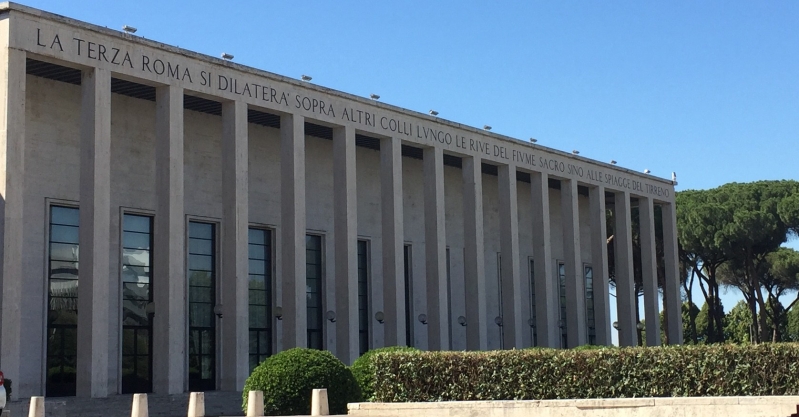
‘…along the banks of the sacred river, as far as the Tyrrhenian shores’ (EUR, 6/7/2017)
Similarly, on Thursday evening, at our visit to EUR we saw the famous inscriptions emphasising the River Tiber as a vital artery connecting Italy with its renewed twentieth-century status as a Mediterranean superpower, and characterising Italians as navigators, a nod to the importance of proximity to the sea by way of that watery road.

Getting a straight line-up together in the cortile at the Palazzo Orsini-Taverna proved harder than one might think… (5/7/2017)
Wednesday evening was the first of our formal lectures, a tour-de-force exposition of what the terminology of the ‘palimpsest’ means when thinking syn- and diachronically about cities, delivered by Prof. Davide Vitale of the University of Arkansas Rome Center (based at the beautiful and evocative Palazzo Orsini-Taverna). I heard students dropping the term blithely into conversation over the following days, and am in awe of how well Davide managed to capture them with this new earworm at the end of another long hot Roman day!
The temperatures were in the mid- to high 30sC all week, so alongside breaks where possible during the early afternoon, we reconvened when it was cooler for evening activities.

Contextualising history with politics, architecture, and museology (Ara Pacis, 5/7/2017)

The Ara Pacis is not just re-located but significantly reconstructed. A fitting backdrop after our analysis of ‘spoliation’ (5/7/2017)

Discussing how museums curate objects and how objects relate diachronically to sites… (Ora Pacis, 5/7/2017)
After our lecture on the politics of architectural history we thus strolled briskly to the Ara Pacis Museum to look at a very old object (the Altar of Peace, commissioned for Augustus by a grateful Senate to celebrate peace in the empire and at Rome; dedicated in 9 BCE), significantly restored and reconstructed in a new location, excavated using cutting-edge technology, contextualised by a Piazza proud with fascist-era sloganeering and bombast, contained within a new museum (one of the only new buildings permitted to be built in the city’s historic heart) an external wall of which bears the autobiographically styled account by Augustus of his array of ‘things achieved’ (Res Gestae Diui Augusti).

‘This is the place where the spirit of Augustus soars on the breeze; after the mausoleum of the emperor was extracted from the darkness of past generations and the scattered components of the Altar of Peace were remade Mussolini, as commander, decreed the destruction of the old, narrow places, and the creation of magnificent streets, buildings, shrines — fitting adornment for the human way of life in the year 1940, year eighteen of the restoration of the fasces.’ (5/7/2017)

Reading up on Augustus’ achievements… (RGDA, 5/7/2017)
Phew. Not to mention that like the Colosseum (where we ended up on Tuesday lunchtime), the Mausoleum of Augustus (the centrepiece of the Piazza) too will be subject to a restoration enabled by a public-private partnership, bankrolled by Italian commercial and telecoms giants. This, we decided, bore thinking about.
Day 4 (6 July 2017)
Thursday 6 July was another very early start: 0730 at a caffe near St. Peter’s Basilica. St. Peter’s gave us a chance to think about how this part of the city had been re-zoned by the collapse of the Roman Empire in the West, the rise of the Papacy, and the seismic shift operated by the fall of Constantinople leading in large part to what would become known as the Renaissance (with all the architectural, political, economic, artistic, and religious shifts that entailed).

From Egypt in 37 CE, this obelisk marks up the impact of empire on Rome (6/7/2017)

St. Peter’s. Luxury, omnipotence, mystery: qualities borrowed for new empires from old (6/7/2017)

Spoliated materials make their point magnificently. One more instance of the continuity from antiquity to the beginnings of modernity (6/7/2017)

By 0930 we had spent well-over an hour in St. Peter’s (6/7/2017)

As we gazed up we recalled the technocratic resources of imperial Rome (6/7/2017)
The world really was changed as humanocentric theories of the cosmos were challenged (and eventually overturned) and the Catholic Church began the counterattack against ‘protesting’ voices unhappy with the style, ethos, and manner of central religious government.

St. Ignazio, where a trompe l’oeil ceiling (and dizzyingly fake dome) helped students think about how the counter-reformation Catholic Church fought back… (4/7/2017)
From the church of St. Ignazio with its emphasis on the unknowability of the logic and language of the divine (unless mediated by the Church for its flock) to St. Peter’s (with its massive evocation of classical forms to lend authority, scale, and wow-factor, while reminding pilgrims that Catholicism remained Peter’s foundation and an earthly manifestation hinting at ineffable heavenly glory), we saw again and again how the urban vocabulary of classical antiquity and ancient Roman innovation formed vital motifs in successive negotiations of civic power and authority.
The Vatican also, of course, recalls the Lateran Treaty (1929) and the rapprochement between Church and State that saw the papacy make peace with Mussolini in exchange (among other things) for territorial rights. We saw flickers of this as we studied the iconography and design of the buildings left representing what was to be a showpiece of Mussolini’s fascist (from the Latin term fasces, the name for the symbols of office associated with the magistrates of the Res Publica) vision.

Antiquity, Christianity, and politics jostle in this unusual frieze (EUR, 6/7/2017)
Concretised in a grand exhibition (Esposizione Universale di Roma, EUR) in 1942, this vision was to illuminate the modern capital city and (not long ago unified) nation as a ‘Third Rome’ (after the Emperors and the Popes). It would have stressed both the continuity and majestic progress embodied in Italy’s new and improved redevelopment of imperial status.
We had an unexpected transport strike to deal with that day, so Agnes’ ability to hire us a minibus (blessedly, with air conditioning — by 1600 when we were leaving for EUR the heat was intense) last minute was totally miraculous!
Our minibus moved us in style between key sites at EUR (sadly, the Museo della Civilta Romana is still closed), then returned us to the city centre where we variously went for a quick drink and/or a gelato before reconvening for our second evening lecture of the week: Miriam’s introduction to the ideological design linking botany, art, architecture, religion, history, and politics at the Villa d’Este, where we would conclude our visits the following day.

The obelisk form kept its power (Marconi obelisk, EUR, 6/7/2017)

Nobody mention James Bond…! (EUR, 6/7/2017)

From one Colosseum to another (EUR, 6/7/2017)

The Fendi restoration makes this ageing palazzo speak anew (EUR, 6/7/2017)
Day 5 (7 July 2017)
Friday morning saw many bleary faces. My impression is that the LANS students made a night of it and fully enjoyed Rome’s summer party atmosphere. I, by contrast, had embraced an early night. We set out for Tivoli in our mini-bus at 0830, and after a pity-pit-stop for coffee / cold drinks / cake at the nearby bar we tackled the archaeological site of the country estate said to have been designed by the Emperor Hadrian. Agnes had designed a route to give maximum thematic value and access to key zones while also keeping us moving between water fountains and patches of shade.

Orientation: Villa Adriana (7/7/2017)
Crucial discussions picked up on the power of scale and decor, and the relationship of designed space to movement patterns and ideology. In a site as big as this one, with so many unique and complex architectural forms to get to grips with, the most important thing for LANS students was to understand the complex interrelationship between such disparate areas of expertise and authority, and the significance of buying in (or knowing how to source) expertise when novel problems appear.
This slideshow requires JavaScript.
Hadrian, an emperor famed for forcing his ‘court’ to join him at his out-of-town villa (or on-tour across the empire), dabbled in architecture and philosophy, and wrote poetry (as well as governing most of the known world). After lunch at the hill town of Tivoli we finished our week’s work with the water-fantasia that is the Villa d’Este.

The villa spreads out in the Palazzo’s frescoed rooms, an imagined sight available for real through the window… (Villa d’Este, 7/7/2017)

Waiting for the Fountain of the Organ to play… (7/7/2017)

What a team! (7/7/2017)
This sixteenth-century palazzo and garden complex, designed for Cardinal Ippolito II d’Este by architect and antiquarian Pirro Ligorio (just as Ligorio was excavating the nearby site of Hadrian’s villa, for his patron the Cardinal — see a googlebooks preview of David R. Coffin’s 2004 study of Ligorio here), is now a UNESCO World Heritage site, but sadly diminished in terms of the working hydraulics as originally envisaged.

(not exactly) one hundred fountains (Villa d’Este, with Rome real and imagined on the horizon; 7/7/2017)

‘Rometta’ — no longer the simulacrum of the city, once this fountain stood between the Cardinal and his guests as they faced Rome. And in Ligorio’s fantasy hydraulics, ancient and papal cities were surpassed (7/7/2017)
We were lucky to have Miriam as our guide for the gardens because her research is breaking new ground in explaining how the somatic, architectonic, natural, economic, hydraulic, political, religious, and personal all coalesce in a stroll through the water-feature filled terraces. I’m not going to give away Miriam’s original analysis in this blog! Lucky students got a sneak preview, everyone else reading this will have to wait for the completed thesis.

Trattoria Polese (7/7/2017)

Diana and Miriam wrapping things up! (Trattoria Polese, 7/7/2017)
Suffice to say that the stimulating and cooling properties of the Villa d’Este made for a perfectly judged end to a memorable trip, which concluded that night with a very convivial dinner at Trattoria Polese.
There was genuine emotion on display as our meal ended, coffees were drunk, and Miriam and I made a closing address to sum up some of what we hope and believe the week achieved. It’s been a real privilege to share this intensive learning experience with such a great group!



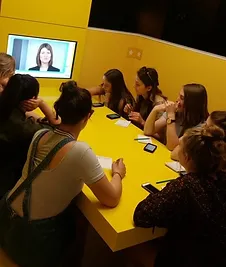
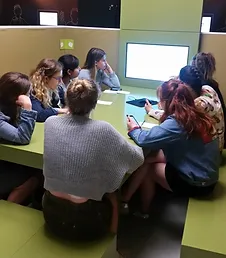



















































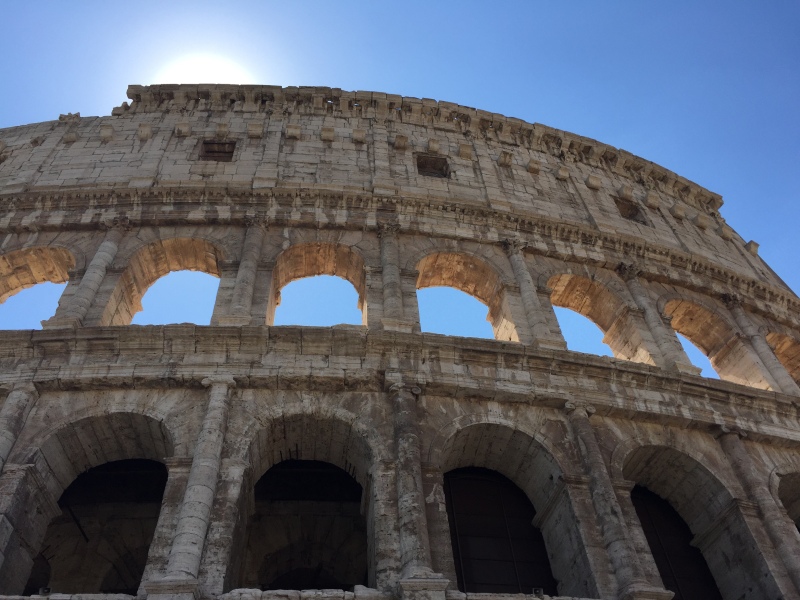





















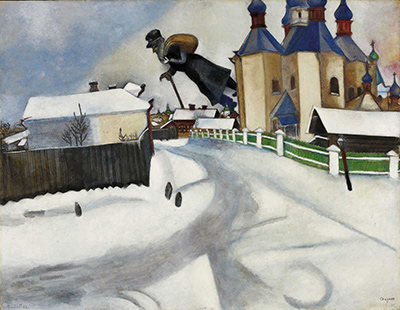
 rtrayed through a remarkable flow of capoeira, martial arts and stunningly athletic dance. The result is hard to put into words. The stark lighting, making use of black and white, with rare flashes of yellow, the arresting artistry and deft expression of the dancers, accompanied by a moving electro-rock soundtrack by the Polish prog band
rtrayed through a remarkable flow of capoeira, martial arts and stunningly athletic dance. The result is hard to put into words. The stark lighting, making use of black and white, with rare flashes of yellow, the arresting artistry and deft expression of the dancers, accompanied by a moving electro-rock soundtrack by the Polish prog band 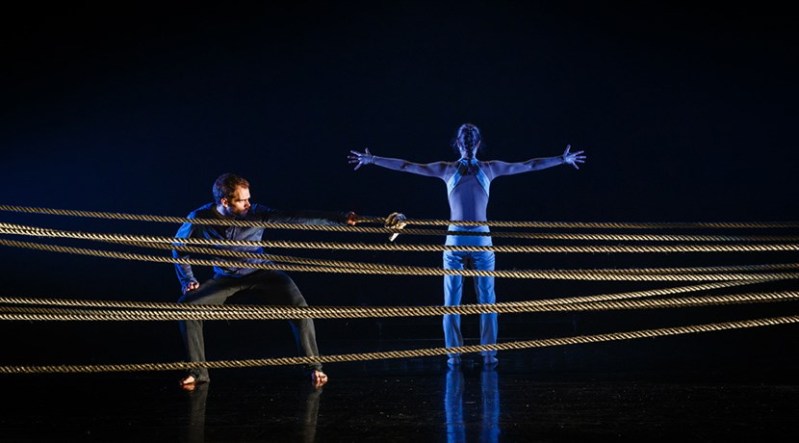 Every dancer was perfectly poised, panther-like in their bounce and stealth, radiating strength and artistry in a way that I could never have expected when I settled into my seat that evening. The performance was creative and innovative in every aspect. There were times when they were all linked together and sailed over and under one another in a way that did not seem possible, even as they proved me wrong. The James Wilton Dance company gave us something unique, something startling, something powerful.
Every dancer was perfectly poised, panther-like in their bounce and stealth, radiating strength and artistry in a way that I could never have expected when I settled into my seat that evening. The performance was creative and innovative in every aspect. There were times when they were all linked together and sailed over and under one another in a way that did not seem possible, even as they proved me wrong. The James Wilton Dance company gave us something unique, something startling, something powerful.